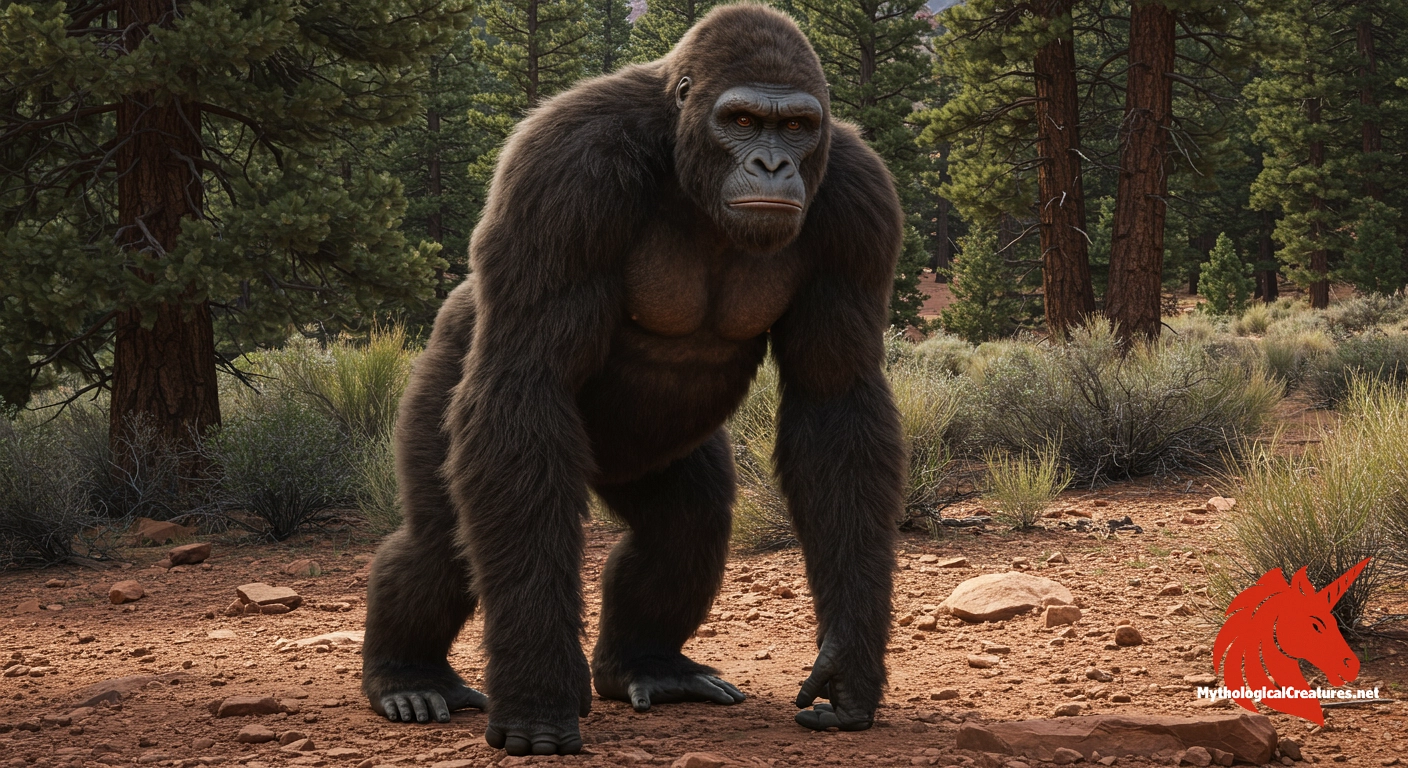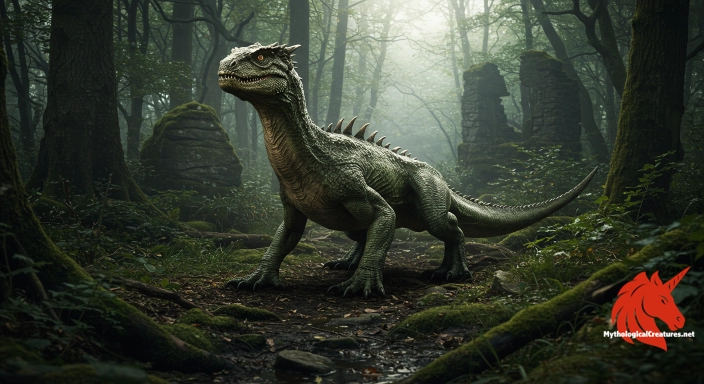Mogollon Monster: The Mogollon Monster is an ape-like cryptid reported in Arizona.

Mogollon Monster
Mogollon Monster - A central figure in local cryptid reports and regional folklore, it remains an enduring mystery in North American myth.
Origins & First Encounters
The Mogollon Monster inhabits the rugged wilderness of central and eastern Arizona, emerging as a distinctive figure in local cryptid lore. Its reputation as the Arizona Bigfoot has grown over decades, with tales that blend indigenous myth with modern eyewitness accounts. The creature is shrouded in mystery, its origins often linked to ancient peoples and the enigmatic landscapes of the Mogollon Rim. Early attestations, although sparse, hint at a long-standing presence that predates contemporary media coverage. Local narratives imbue the monster with qualities of both guardian and outcast, reflecting a deep cultural connection to the natural environment. Every whispered account and late-night sighting has added layers to this evolving legend. The enduring fascination with the Mogollon Monster underscores a broader human desire to understand the uncharted and the unexplained. As the myth continues to evolve, it stands as a symbol of the wild, unpredictable spirit that haunts the untamed corners of the American Southwest.
Source Texts & Tale Variants
Eyewitness testimonies and oral traditions form the backbone of the folklore surrounding the Mogollon Monster. Local residents have passed down accounts of eerie encounters through generations, each retelling adding new details and perspectives to the narrative. Newspaper articles from the mid-20th century began to document these mysterious sightings, lending a modern twist to an age-old story. Regional ballads and campfire stories have also enriched the legend, merging factual observation with imaginative embellishment. Various versions of the tale describe the creature as both a protector of sacred lands and an ominous presence forewarning unseen dangers. In some accounts, sightings are intertwined with the rhythms of nature, such as unusual weather or rare astronomical events. Indigenous storytellers have integrated the monster into their own mythic frameworks, sometimes associating it with spiritual guardianship. This rich mosaic of sources reflects the complexity of the creature’s legacy and invites ongoing debate about the boundaries between myth and reality.
Form & Powers
The physical depiction of the Mogollon Monster portrays it as an imposing, ape-like entity with a robust and muscular build. Witnesses often describe a thick coat of matted hair that spans a spectrum from deep brown to hints of reddish tones, echoing the colour palette of the surrounding desert. Its face, a curious blend of human-like expressiveness and animalistic rawness, is said to feature intense, deep-set eyes that seem to capture the mysteries of the night. Long, exaggerated limbs and oversized hands further accentuate its resemblance to classic primate legends. Detailed observations suggest a creature adapted for stealth, moving with a deliberate and almost silent gait over rugged terrain. Some descriptions highlight an almost spectral glow from its eyes during twilight hours, enhancing its enigmatic allure. The creature’s overall anatomy speaks of a life honed by the rigours of harsh, arid environments, yet it retains an uncanny familiarity to other ape-man legends. Such a composite of well-known and surreal features has cemented the Mogollon Monster’s status as an enduring figure in American folklore.
Regional Faces
Although the Mogollon Monster is most closely associated with the Arizona desert, its legend has travelled across neighbouring regions, inviting a wealth of local reinterpretations. In areas bordering Arizona, sightings share common traits yet are often coloured by distinctive regional lore. Some communities in adjacent states describe the creature with a slightly softer demeanour, sometimes even suggesting a mystical rather than menacing presence. Local indigenous traditions sometimes depict the monster as a revered spirit, a guardian whose appearance signals respect for the natural world. The changing landscape from arid desert expanses to more wooded or canyon-filled terrains has led to variations in its descriptive details and behavioural traits. In the high desert and mountainous fringes, the creature is occasionally portrayed as an elusive apparition blending with the shadows. Such regional adaptations underscore the flexible nature of the legend and its capacity to mirror the diverse environments of the American Southwest. The evolving narratives across different areas not only enhance the creature’s mystique but also highlight the universal appeal of mysteries that defy simple explanation.
Cultural Parallels
The legend of the Mogollon Monster resonates with similar myths found around the world, creating intriguing cultural parallels. Its resemblance to the American Bigfoot is immediately apparent, yet the Arizona setting grants it a unique character influenced by local geography and tradition. Comparable cryptids, such as the Himalayan Yeti, share the motif of a large, elusive creature lurking at the edge of human civilisation. European folklore also echoes these themes through tales of wild men and mysterious forest dwellers. In each instance, these creatures symbolise humanity’s deep-seated fascination with the untamed and the mysterious elements of nature. The Mogollon Monster, like its global counterparts, embodies the tension between modern rationality and the allure of the supernatural. Variations like the Florida Skunk Ape further illustrate how similar entities adapt to vastly different environments while maintaining a core mythological appeal. Through this comparative lens, the creature becomes part of a wider dialogue that spans diverse cultures and celebrates the enigmatic interface between the natural world and human imagination.
Legacy & Modern Evolution
Over the decades, the Mogollon Monster has transformed from a shadowy local legend into an emblematic figure in American cryptid folklore. Early oral traditions have merged with modern media portrayals, creating a layered narrative that captivates both sceptics and believers alike. As reportage shifted from whispered campfire stories to newspaper columns and television documentaries, the legend adopted a dual identity—both mythic and modern. Contemporary accounts often interlace scientific curiosity with a reverence for the unknown, reflecting a broader societal interest in unexplained phenomena. Festivals, art exhibits, and local merchandise have all contributed to cementing the creature as a cultural icon within the region. Technological advances and the rise of digital media have further amplified its presence, spurring online discussions and amateur investigations. This evolution mirrors society’s enduring fascination with the wilderness and the possibility that ancient mysteries may still lurk in the shadows. In its modern legacy, the Mogollon Monster stands as a reminder of nature’s enduring power to inspire wonder, fear, and an unquenchable desire to explore the unknown.
Interesting Fact
An interesting observation is that, despite its resemblance to Bigfoot legends across North America, the Mogollon Monster is specifically tied to the unique geography of Arizona's Mogollon Rim, highlighting regional variations in cryptid lore.
Quick Creature Info
Origin:
Features:
Our Mythic Legendary Rating:

Also Sometimes Known As:
Habitat:
Supernatural Powers:
Physical Attributes:
Abilities:
Behavior:
Lore:
Related Creatures, Tales or Lore
- BBigfoot
- SSasquatch
- SSkunk Ape
References
Discover Another Mythical Legend You May Not Have Heard Of?
Uncover the mysteries of ancient folklore and expand your knowledge of legendary beings from cultures around the world.
Dare to Meet the Bisterne dragon....
Curated by the Mythological Creatures Team (rev. May 2025)
